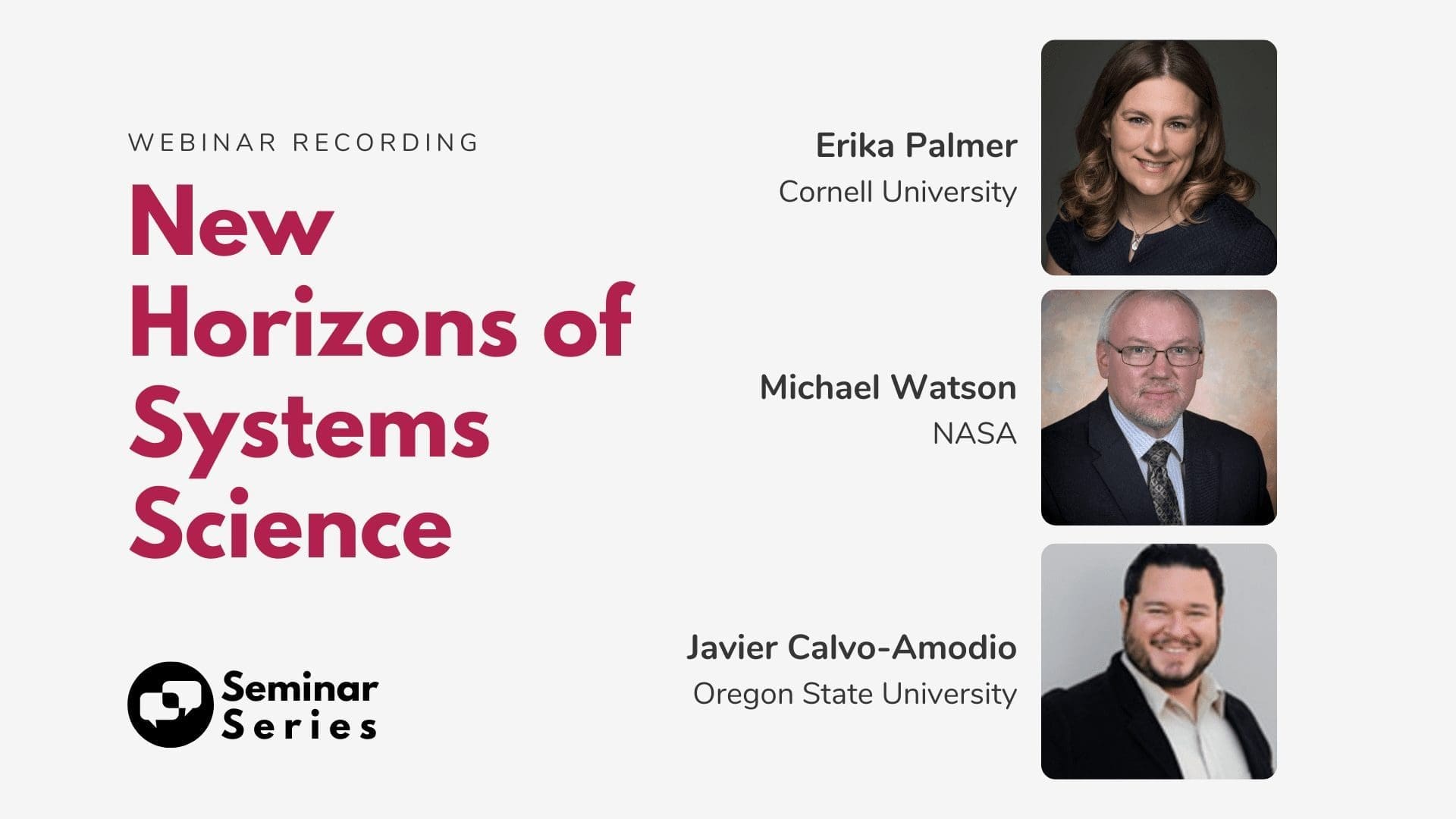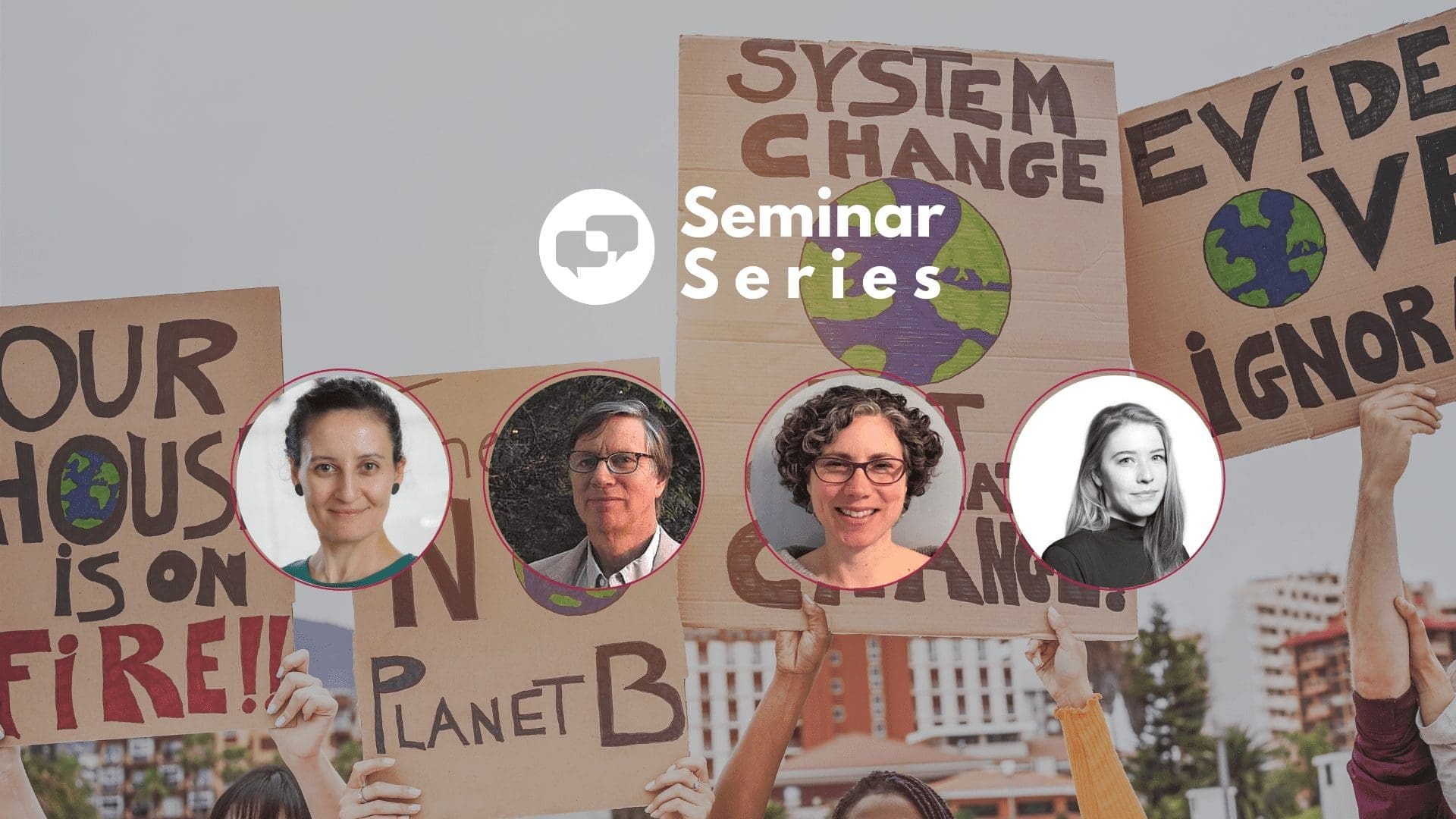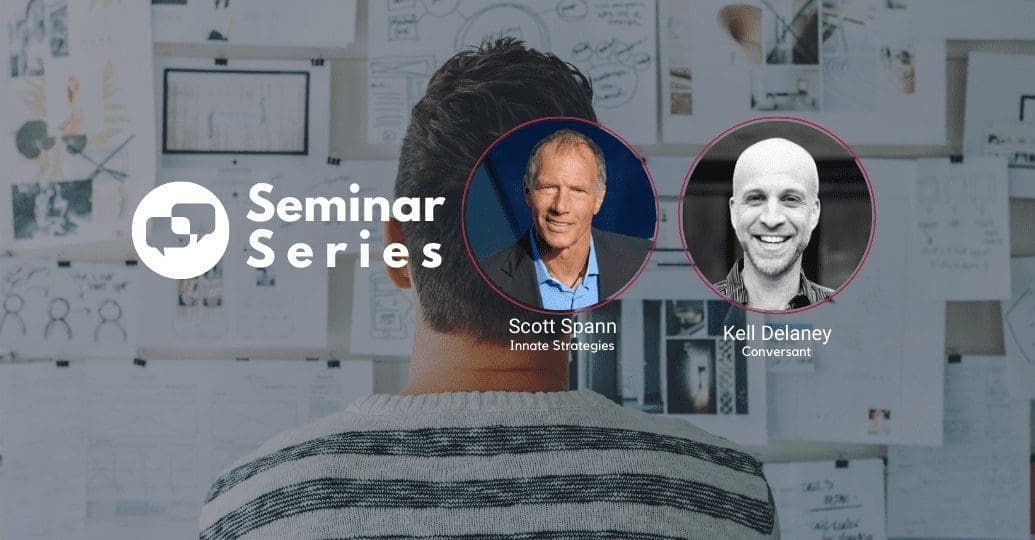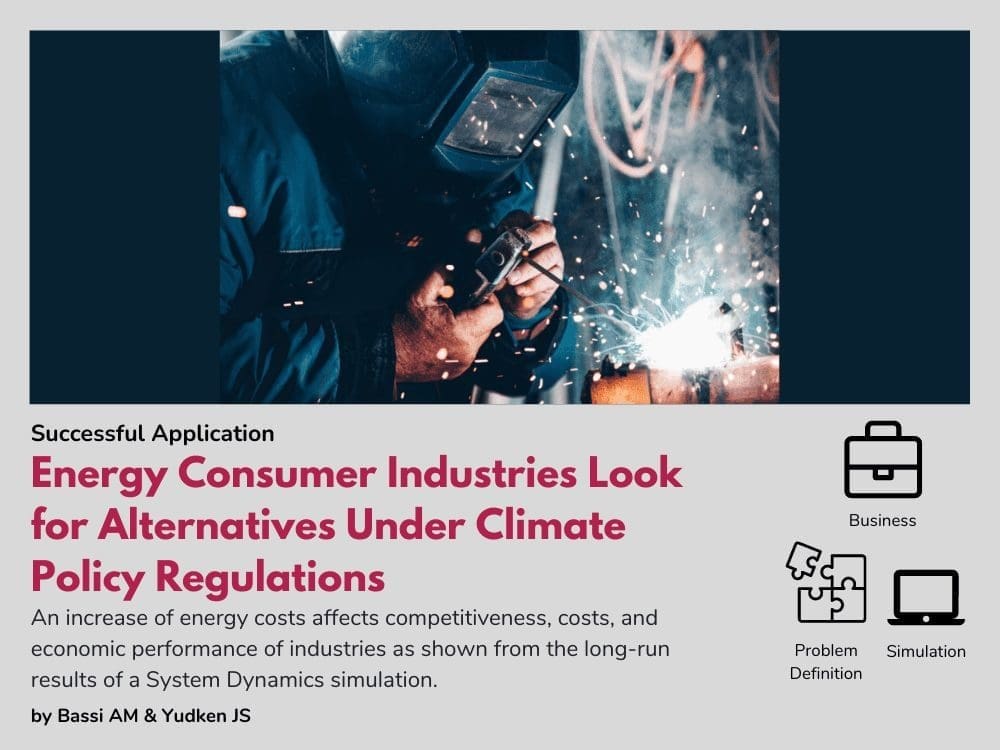New Horizons of Systems Science
New Horizons of Systems Science
This Seminar was sponsored by the International Council on Systems Engineering (INCOSE).
Systems theory is developing to include new perspectives with a focus on integrated and inclusive transdisciplinary system approaches. This panel discusses new advances in systems science including critical systems thinking, social/socio-technical systems, and complex systems, which come together in the systems engineering principles. They also discuss where Systems Dynamics fits into this picture as well as other types of systems models.
By providing three perspectives on the discipline of Systems Engineering, the panelists shared a wide range of insights and experiences. What the perspectives shared were ways Systems Engineering practitioners and the System Dynamics community could work together going forward. One key to making New Horizons for System Science become reality is to merge the insights and experiences of each group into a shared, and sharable, practice.
The relationship between Systems Science, Systems Thinking, and Systems Engineering is a key to understanding the range of applicable solution patterns
Erika Palmer began with the hope that both organizations, INCOSE and the System Dynamics Society, would continue to engage, learn, and innovate as part of a worldwide collaboration. The goal of the INCOSE panel is to foster an inclusive dialog on Systems Science. The purpose of the dialog is to accelerate the exchange and adoption of tools, techniques, and theories between the two sets of practitioners.
Michael Watson shared with the attendees that the upcoming release of System Engineering Principles will include Sociology as a topic. By setting out the fifteen principles of Systems Engineering concisely, System Dynamics solutions can be applied to the principles. Common patterns used across domains or across principles will provide leverage for other contributors.
Javier Calvo-Amodo shared insights from the perspective of building Systems Science disciplines and that students can participate with journal articles. Since System Dynamics provides a specific lens through which to view models, it can be used to validate the findings of other modeling types or to provide insights into what other modeling systems might reveal. A Systems Science map using Randomness and Complexity as the axes provided a guide to where specific System Dynamics developments can be best applied.
Erika Palmer (Cornell University) began with the hope that both organizations would continue to engage, learn, and innovate as part of a worldwide collaboration. The goal of the INCOSE panel is to foster an inclusive dialog on Systems Science. The purpose of the dialog is to accelerate the exchange and adoption of tools, techniques, and theories between the two sets of practitioners.
Michael Watson (NASA) shared with the attendees that the upcoming release of System Engineering Principles will include Sociology as a topic. By setting out the fifteen principles of Systems Engineering in a concise manner, System Dynamics solutions can be applied to the principles. Common patterns which apply across domains or across principles will provide leverage for other contributors.
Javier Calvo-Amodo (Oregon State University) shared insights from the perspective of building Systems Science disciplines and that students can participate with journal articles. Since System Dynamics provides a specific lens through which to view models, it can be used to validate the findings of other modeling types or to provide insights into what other modeling systems might reveal. A Systems Science map using Randomness and Complexity as the axes provided a guide to where specific System Dynamics developments can be best applied.
Complex systems are engineered by complex organizations.
Watch the recording below
Q&A
Q: Question to Javier: Why are there so few academic programs in Systems Science compared to Systems Engineering? Is this a problem?
A: They require interdisciplinary approaches, which are difficult to implement as they usually would span across different colleges within a university (e.g. College of Science, College of Liberal Arts, College of Business, College of Engineering, etc.)
Q: Question to Javier: What textbooks or papers would you recommend for learning more about systems science theory and the principles of systems science?
A: I recommend the following: Introductory: Cabrera, D., & Colosi, L. (2008). Distinctions, systems, relationships, and perspectives (DSRP): A theory of thinking and of things. Evaluation and Program Planning, 31(3), 311-316. and Cabrera, D., & Cabrera, L. (2022). DSRP Theory: A Primer. Systems, 10(2), 26.
Original work on systems science: Bertalanffy, A. R., Boulding, K. E., Ashby, W. R., Mead, M., & Bateson, G. (1968). L. von Bertalanffy, General System Theory. New York: George Braziller. and Von Bertalanffy, L. (2010). General systems theory. The Science of Synthesis: Exploring the Social Implications of General Systems Theory, 103.
Latest work on systems science: Rousseau, D. (2015). General systems theory: Its present and potential. Systems Research and Behavioral Science, 32(5), 522-533.;
Rousseau, D. (2018). On the architecture of systemology and the typology of its principles. Systems, 6(1), 7.
Rousseau, D., Billingham, J., Wilby, J., & Blachfellner, S. (2016). In search of general systems theory. Systema, 4(1).;
Rousseau, D. (2018). A framework for understanding systems principles and methods. Insight, 21(3), 9-18.;
Rousseau, D., Billingham, J., & Calvo-Amodio, J. (2018). Systemic semantics: A systems approach to building ontologies and concept maps. Systems, 6(3), 32.
Q: Can you suggest further introductory reading on category theory? This is new to me and a bit uncomfortable with this framing
A: Conceptual Mathematics by William Lawrence
Q: One thing caught my attention comments from Mike…. we need …. “to help build the complex system” and this…. helps… “development of a complex system”…. this is quite different from the underlying philosophy of System Dynamics where the emphasis is often trying to understand an existing system and adjust
A: The difference is in the context and/or domain of application; SD is designed to understand the underlying structures that give rise to System Dynamics as a means to understand from a high-level perspective how the system works. While useful for that purpose, the SD perspective places its main focus on control through feedback and feedforward loops, which may not capture other systemic and holistic arguments necessary to realize a complex engineered system. This is in alignment with Prof. Mike Jackson’s CST and CSP.
Q: Michael’s explanation of Category Theory introduced several concepts that are new (at least, new to me). Does INCOSE offer an introductory reference to supplement his insights?
Yes, go to INCOSE Systems Science Working Group Wiki and search in meetings. We have several presentations by Category Theorists in the meetings section.
Q: How would you differentiate between detailed complexity and dynamic complexity?
A: Those are two kinds of complexities that might or might not be present at the same time.
Q: The term engineering can mean the designing of a system, but is also heavily based on the activity of problem-solving. System Dynamics has problem-solving very strongly in its intellectual foreground. How are the latter activity and strength of System Dynamics used in Systems Sciences activities?
A: Causal loop diagrams and if needed the following simulation can be very powerful to help initial conceptualizations of complex problems. But they rarely yield the full answer; mostly because the models are difficult to verify and validate rigorously (especially if what is being designed is new and there is no frame of reference).
Q: Systems thinking means many things to many people some of these definitions are very loose and perhaps meaningless… is this a problem? Can it be fixed?
A: We believe that Derek Cabrera’s definition is quite good (it was developed using the scientific method). See Cabrera, D., & Colosi, L. (2008). Distinctions, systems, relationships, and perspectives (DSRP): A theory of thinking and of things. Evaluation and Program Planning, 31(3), 311-316. and Cabrera, D., & Cabrera, L. (2022). DSRP Theory: A Primer. Systems, 10(2), 26.
Q: How do we reduce the distance between the research and practice in Systems Engineering? The gap is much wider than, say, between physics and electrical engineering.
A: That is an excellent question that requires a much longer answer than what I can provide here. At the Systems Science Working Group, we are tackling exactly that. What I can say for certain is that we first MUST begin by defining the theoretical foundations for systems engineering. We have several projects working on that. Join us at INCOSE International Workshop to learn more.
Q: Can one mention articles and cases where the presented principles (of both speakers) are applied?
A: Calvo-Amodio, J., & Rousseau, D. (2019). The human activity system: Emergence from purpose, boundaries, relationships, and context. Procedia Computer Science, 153, 91-99. ;
Kittelman, S., Calvo‐Amodio, J., & Martínez León, H. C. (2018). A systems analysis of communication: defining the nature of and principles for communication within human activity systems. Systems Research and Behavioral Science, 35(5), 520-537.;
Taylor, S., Calvo-Amodio, J., & Well, J. (2020). A method for measuring systems thinking learning. Systems, 8(2), 11.;
Q: Why haven’t we seen System Dynamics modeling get as much attention as did machine learning modeling in recent years?
A: It is difficult to verify and validate rigorously.
Q: Does “Organized simplicity” equate to a reductionist approach?
A: Not quite, but the reductionist approach is most efficient in an organized simplicity
Q: Can you please talk about the role of soft systems methods (problem structuring methods for example) in systems engineering? They are useful in scoping poorly understood problem spaces but you rarely see them linked directly to System Engineer.
A: They are very useful to help address the social aspects of Systems Engineer endeavors (John Warfield and Peter Checkland developed their approaches (IM and SSM) to help with this issue); however, it is important to have frameworks that help us integrate all approaches. Mike Jackson’s CST and CSP are great foundations.
Q: Any books you’d recommend?
Mike Jackson’s 2019: Managing Complexity
Q: In System Dynamics, we often talk about the dynamic problem and the reference mode, then try to mode the system with the dynamic problem in mind. What might be the code switch for Systems Engineering’s approach?
A: There is no code switch conceptually. I would say that in Systems Engineer we look at requirements, value, or mission, and we design based on those (maybe similar to dynamic hypotheses, but not quite the same). We use MBSE (model-based System Engineer), in particular, a digital twin as the closest to a reference mode, but these are not isomorphic.
Erika Palmer is a Senior Lecturer in the Cornell Systems Engineering Program. She is the founder and chair of the Social Systems Working Group (SocWG) at the International Council for Systems Engineering (INCOSE); the Americas lead for Empowering Women Leaders in Systems Engineering (EWLSE) at INCOSE and represents Cornell on INCOSE’s Academic Council.
Michael D. Watson is the chair of the INCOSE Complex Systems Working Group and chair of the Systems Engineering Principles Action Team. He is the Technical Advisor in the National Aeronautics and Space Administration (NASA) Marshall Space Flight Center (MSFC) Advanced Concepts Office. He graduated with a BSEE from the University of Kentucky in 1987 and obtained his MSE in Electrical and Computer Engineering (1996) and Ph.D. in Electrical and Computer Engineering (2005) from the University of Alabama in Huntsville.
Javier Calvo-Amodio is an Associate Professor of Industrial Engineering at Oregon State University; Chair of the Systems Science Working Group at INCOSE and Deputy Editor of Systems Research and Behavioral Science Journal. His research focus is on developing a fundamental understanding of how to integrate systems science into industrial and systems engineering research and practice to enable better engineering purposeful human activity systems.
Present at the Seminar Series
The Society Seminar Series consists of periodic online meetings on topics of interest to the systems thinking and System Dynamics communities. These virtual activities cover a wide range of topics that cross many domains while bringing together academics, practitioners, and students together for learning and lively discussion. Send your seminar proposal here
Sponsor a Seminar
The Society is actively looking for Seminar sponsors. This allows making a seminar open to all and free of charge. If your organization would like to sponsor one of these events, where you can promote your organization, firm or software, for instance, contact us at office@systemdynamics.org
Recent Posts
Society Governance Updates
New System Dynamics Society leadership
Call for Presenters: Seminar Series
Share your insights in the System Dynamics Society Seminar Series. Submit your proposal and join a global community of experts
Honoring Excellence: A Glimpse into the Awards of the International System Dynamics Conference
Dive into the prestigious awards and honorable mentions of the International System Dynamics Conference, celebrating trailblazers and emerging talents in the field
Upcoming Events
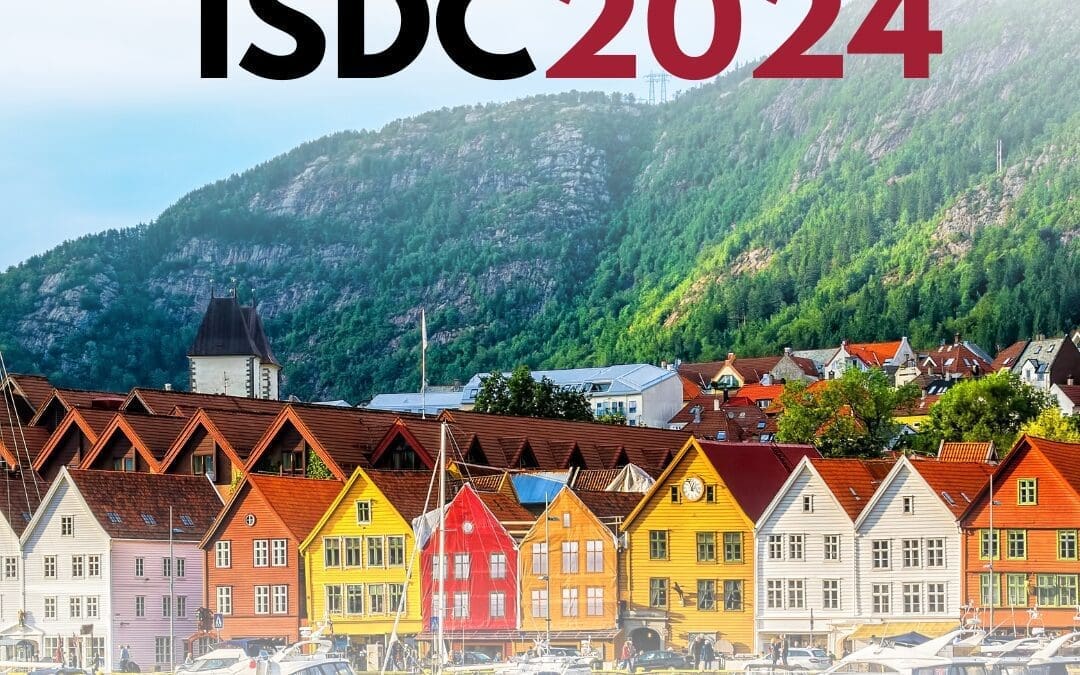
2024 International System Dynamics Conference
The International System Dynamics Conference is coming to Bergen! Save the date: August 4-8, 2024. We hope to see you there! #ISDC2024
Recent Business cases
System Dynamics Helps Evaluate Anticipatory Action on Cholera Outbreaks
Humanitarian agencies encourage anticipatory action in disaster response to cholera outbreaks in the Democratic Republic of Congo.
Management Design for Planted Forests in Japan Using System Dynamics
Hanno City in Saitama Prefecture used a system dynamics model to enable detailed analysis of labor requirements and changes in forest conditions.
Solving Bottlenecks in Dairy Production Facilities with System Dynamics
FriedslandCampina employed system dynamics to strategically enhance production efficiency in the midst of factory merging.
Join us
System Dynamics for Climate Change Mitigation
System Dynamics for Climate Change Mitigation
We had an insightful Webinar with the participation of With Juliette Rooney-Varga, Carolyn McCarthy, Sibel Eker, and Steve Arquitt .
Integrated System Dynamics models of economy and environment have long been used for research and decision support for sustainability problems, starting with the seminal work of World Dynamics and Limits to Growth. We discussed how System Dynamics models support decision-making, stakeholder, and public engagement for climate change and sustainability problems. We reflected on existing models and tools, such as Climate Interactive’s En-ROADS and Millennium Institute’s iSDG tool, and their use cases. We also discussed how the Climate Change Initiative at UMass Lowell uses System Dynamics tools to raise awareness on climate change.
If you’re a member, you can watch the webinar recording here.
Below are the answers to questions asked live during the Webinar.
Learn more about the Seminar Series.
Q&A Seminar | System Dynamics for Climate Change
Climate Interactive:
How would you describe the interaction between complex models (GCMs …) and simpler system dynamic models in more detail? (how can they support each other?)
Shortly, large detailed models help for cross-validating the simpler models. In return, simple models support the complex models in stakeholder engagement and scenario co-production.
What are the similarities between the EN-Roads Model & the iSDG Model? What are the main differences?
Both EN-Roads and iSDG are based on the System Dynamics method. Both emphasize transparancy, user friendliness, and shared learning. Both place great emphasis on facilitation and support in shared learning. The differences: EN-Roads is a global model, where iSDG is customized to support planning in a particular country or geographic region. EN-Roads is focused on strategies to keep global temperature below a specified level, where iSDG’s focus is more diffuse taking on all the SDGs.
What are some of the major impacts that the Climate Interactive team see on the application side of the models?
This question was not clear to me during the webinar. If “application” means the use of Climate Interactive’s models, we see quite a substantial impact. Only En-ROADS has been used in 73 different countries so far, engaging almost 63000 people. We have a wide audience, from policymakers and philantropists to higher education students and community members. One of the most striking and uplifting recent examples of En-ROADS outreach is the events organized by one of our ambassadors with smallholder farmers in Tanzania.
Why don’t you use python as the intermediate language? Thanks
Answered during the webinar. Python is a user-friendly language but not as fast as C. We need speed in interactive simulators, so the Vensim model is converted to C.
Are system dynamics models being used in conjunction with Big data and AI?Can system dynamics models learn with machine learning?
There are initiatives about this as far as I know, and ML is very useful for quantifying empirical relationships, but outsourcing the model building completely to AI is not possible, neither desirable in my opinion. System Dynamics’s main strength lies in its descriptive nature, accessibility and understandability. While a hard coupling of SD and machine learning can provide many benefits, it might override the main strengths.
Since there seems to be many questions/comments regarding implementation/compliance, might it be helpful to start focusing on modeling the topic of governance itself, in order to identify and understand the influencing dynamics and loops on the gaps between the ideal solutions actually implemented?
In general, especially regarding specific sustainability governance problems, I agree that this should be the approach, because problem delineation and understanding the system strructure is key to developing any solution. In En-ROADS, though, the primary purpose is public engagement around the topic of “solutions”, hence the underlying dynamics are not co-modelled but shared with the users through various indicators and graphs.
Does the Climate Interactive climate-economy feedback have anything to do with Nordhaus’ “damage” function?
Since En-ROADS is an interactive simulator, it includes a damage function that allows the users to experiment with various “damage functions” found in the literature, including Nordhaus, or make their own assumptions. You can read more about it here
When will the nature-based/land-based parts in En-ROADS be accessible online?
In the next few months. Please check either the En-ROADS simulator or this page
Very interesting presentation Sibel. Can SDeverywhere and the implementation into a website be done by somebody completely unfamiliar with C or Java or any programming? Many thanks.
I must say that it would be a bit challenging for someone who has no programming experience. There are guidelines, though, which might be helpful to get started.
Questions to Millennium Institute
What are the similarities between the EN-Roads Model & the iSDG Model? What are the main differences?
Both EN-Roads and iSDG are based on the System Dynamics method. Both emphasize transparancy, user friendliness, and shared learning. Both place great emphasis on facilitation and support in shared learning. The differences: EN-Roads is a global model, where iSDG is customized to support planning in a particular country or geographic region. EN-Roads is focused on strategies to keep global temperature below a specified level, where iSDG’s focus is more diffuse taking on all the SDGs.
Are parts of iSDG Model publically available?
Yes, go to www.millennium-institute.org/isdg . There you can access a demonstration model, videos on the iSDG, and the model documentation.
To what extent is the Millennium Institute SDG model open source? It would be so nice to use it rather than starting modelling from scratch in every research project.
At this time the iSDG is not open source. iSDG models are developed within the frame of a specific project. However, much can be learned about the model and its structure by visiting www.millennium-institute.org/isdg.
@Steve, how do you integrate “indicators” of SDG’s to report a single metric?
The iSDG reports the status of each of the 17 SGDs separately. The level of performance of the targets falling under each SDG are averaged to calculate the SDG performance. Targets can be thought of as desired levels of indicators. For a complete explanation see https://www.pnas.org/content/pnas/suppl/2019/10/29/1817276116.DCSupplemental/pnas.1817276116.sapp.pdf
SDG and how it is implemented in real world is highly context-dependence – how iSDG address this?
The iSDG is customized for the country or regional setting. Workshops are held with local experts, decision-makers, and stakeholders who review the model and identify key issues and policies to include inthe iSDG model.
Steve’s question regarding connecting real action to the plan is important. How do we make the interactive modeling tools an integral part of follow up and feedback on action?
With climate change and the SDGs both this really hits the crux of the matter. With the iSDG it is important to involve a broad spectrum of stakeholders on the modeling team and in the workshops who are motivated to see that the selected scenarios are being transformed into policies and then funded. This will require a well-trained team that can run scenarios, derive policies and work with the relevant government people to assure implementation. Monitoring is essential, and needs to be built into the projects. I fully agree with Juliette that the models need to engage with citizens who will then push leaders to make the necessary changes. I would love to hear others’ ideas and experiences on this.
Why choose poverty as a key #1 SDG?
“No poverty” as SDG1 was defined and designated by agreement of the 193 Agenda 2030 signatory countries. There is debate about which SDG is the most important. The iSDG takes no position on which SDG is the most important However, in the iSDG poverty is linked to almost every SDG.
Is this model (MI iSDG Tool) built in STELLA?
If you mean the iSDG, yes the model I showed was built in STELLA however we also have a version in Vensim.
What are some of the active projects that MI is doing today?
Currently we are working on iSDG projects in Afghanistan, Bhutan, China, Uganda, Namibia, Djibouti, Kenya, Democratic Republic of the Congo.
This question–or 2 questions–are for Steve. First, are worldviews and values included in the iSDG models? If so, how? A second question relates to how the highest-level decision-makers regard the models. I’m new to SDS but spent a number of years working with a roughly analogous set of high-level
After some relection, worldviews and values are pervasive in the iSDG model by virtue of the SDGs themselves. iSDG is intended to help policy-makers design strategies and allocate resources for attaining the SDGs. This includes the “leave no one behind” principle, gender equity in education and economic opportunities, equitable income distribution, preserving biodiversity for future generations, rule of law and many others.
Questions to CCI
@CCI any tips on how to engage kids with these tools?
Find resources: Comprehensive Facilitator Resources Online World Climate Resources
Steve’s question regarding connecting real action to the plan is important. How do we make the interactive modeling tools an integral part of follow up and feedback on action?
Watch the recording for a full answer
@Juliette, could you say a bit about hope? There is a political divide especially in the US, but I read recently that % of the US population who feels anxious about climate change is ~68%. Could role-play games help deal with this anxiety?
Watch the recording for a full answer
“Research shows that showing people research doesn’t work”. What are your thoughts on this @Juliette?
We agree with John Sterman! But if you want to read more about this research, you can here
Why do you think that higher levels of “hope” begin and end higher with the i-H group?
Watch the recording for a full answer
Was the ethnic cultural diversity in your simulation group meetings more diverse than the photos would suggest? If not it’s concerning that you have a rather restricted sample?
Thank you for this question. The breakdown of participants’ racial and ethnic diversity for Building Consensus for Ambitious Climate Action through the World Climate Simulation can be found on page seven. Limitations relevant to our sample can be found on page 24 and reads, “Our sample was not randomly drawn from the general population and is therefore not expected to be representative of the American public. In addition, because the youngest participants in our study were drawn from programs serving low-income, first-generation-to-college students, age likely correlates with other demographic traits in our sample. We therefore do not claim that the observed effects of the simulation or demographics extend to the general American population.”
Recent Posts
Society Governance Updates
New System Dynamics Society leadership
Call for Presenters: Seminar Series
Share your insights in the System Dynamics Society Seminar Series. Submit your proposal and join a global community of experts
Honoring Excellence: A Glimpse into the Awards of the International System Dynamics Conference
Dive into the prestigious awards and honorable mentions of the International System Dynamics Conference, celebrating trailblazers and emerging talents in the field
Upcoming Events

2024 International System Dynamics Conference
The International System Dynamics Conference is coming to Bergen! Save the date: August 4-8, 2024. We hope to see you there! #ISDC2024
Recent Business cases
System Dynamics Helps Evaluate Anticipatory Action on Cholera Outbreaks
Humanitarian agencies encourage anticipatory action in disaster response to cholera outbreaks in the Democratic Republic of Congo.
Management Design for Planted Forests in Japan Using System Dynamics
Hanno City in Saitama Prefecture used a system dynamics model to enable detailed analysis of labor requirements and changes in forest conditions.
Solving Bottlenecks in Dairy Production Facilities with System Dynamics
FriedslandCampina employed system dynamics to strategically enhance production efficiency in the midst of factory merging.
Join us
Watch the recording below
Systems Thinking, Fast and Slow
Systems Thinking, Fast and Slow
In 2011, the Nobel Prize-winning economist Daniel Kahneman published his best-selling book “Thinking, Fast and Slow”, which extended the work on cognitive biases he had started with his co-author Amos Tversky many years earlier. Kahneman defines two systems of the mind, “System 1”, which jumps quickly to answers through simple heuristics, and “System 2”, which analyzes decisions more deliberately and looks for more evidence.
A person (or organization) with a lazy or undeveloped System 2 can get along fine in routine decision-making but will tend to make mistakes—jumping to incorrect conclusions and bad decisions—when the situation is more complicated and nuanced. The biases causing these mistakes go by such names as confirmation bias, availability bias, anchoring, and the fallacy of “what you see is all there is” (WYSIATI).
Systems thinking and modeling are supposed to help individuals and organizations make decisions more holistically and with all significant factors in mind—that is, to strengthen the role of System 2 in the world.
However, even a systems approach can fall prey to the usual cognitive biases of System 1 if it becomes dominated by certain loud voices in the room, gives too little consideration to all the evidence, applies a rigid template to a situation with potentially important idiosyncrasies, or otherwise rushes to conclusions.
Fast versus Slow may seem to pose a dilemma in the business world, where potential clients have limited time and budgets at their disposal. Although everyone knows that a thorough and careful job is ideal, some systems thinking consultants may be tempted to offer the promise of powerful insights using a “quickie” approach (e.g., using only causal-loop diagrams and no data collection) that takes weeks rather than months. Naive clients may attribute supernatural abilities to a smooth consultant who makes such promises and forget the fact that the problem at hand is difficult and has stymied all previous attempts at a solution.
Although such a consultant may get lucky a handful of times, with clients satisfied in the short term and glad to give a thumbs-up testimonial, that consultant’s luck will sooner or later run out. Short-term improvement will lead to later disaster, and the inadequacies of the consultant will be revealed for all to see. The rise and fall of a single consultant may be no cause for alarm, but if that consultant has convinced an army of others to take the same approach, the result could be catastrophic for the field as a whole. That field will have allowed its sober System 2 side to be smothered by the false attractions of go-with-the-gut System 1.
Fortunately, there is a way around the apparent dilemma, as many experienced system dynamics consultants already know. The solution is to propose a small initial simulation model (supported by data collection but not at a detailed level) for the first several weeks of work. A satisfied client may then choose to go on to a definitive second stage involving more complete data collection and expanded modeling.
As System Dynamics practitioners, we should reaffirm the scientific method and avoid being seduced by “fast” System 1 with its inevitable trajectory of overshoot-and-collapse. We must have confidence that a reliable System 2 approach will serve our clients—and our field—best in the end.
by Jack Homer (VP of Professional Practice)
Recent Posts
How Did En-ROADS Get 755,000 users? Lessons on Modeling, Interface Design, and Facilitation
This article discusses the En-ROADS climate model, detailing its robust modeling, intuitive interface design, effective facilitation, and strategic policy engagement for global impact.
Society Governance Updates
New System Dynamics Society leadership
Call for Presenters: Seminar Series
Share your insights in the System Dynamics Society Seminar Series. Submit your proposal and join a global community of experts
Upcoming Events

2024 International System Dynamics Conference
The International System Dynamics Conference is coming to Bergen! Save the date: August 4-8, 2024. We hope to see you there! #ISDC2024
Recent Business cases
System Dynamics Helps Evaluate Anticipatory Action on Cholera Outbreaks
Humanitarian agencies encourage anticipatory action in disaster response to cholera outbreaks in the Democratic Republic of Congo.
Management Design for Planted Forests in Japan Using System Dynamics
Hanno City in Saitama Prefecture used a system dynamics model to enable detailed analysis of labor requirements and changes in forest conditions.
Solving Bottlenecks in Dairy Production Facilities with System Dynamics
FriedslandCampina employed system dynamics to strategically enhance production efficiency in the midst of factory merging.
Join us
Responding to The Exponential Demand for Systems Thinking
Responding to The Exponential Demand for Systems Thinking
The “demand” for systems thinking has never been greater. Period. And it’s growing. Exponentially. Yet, our ability to meaningfully recognize and respond to that demand comes nowhere near closing such a critical gap – a gap that simply must be closed – especially now.
We had an insightful conversation with Scott Spann (Innate Strategies) and Kell Delaney (Conversant). We explored how to meet the growing demand for systems thinking by reflecting on case studies along with the principles, practices, and processes that emerged from them.
Learn more about the Seminar Series.
Watch the recording below
Recent Posts
Society Governance Updates
New System Dynamics Society leadership
Call for Presenters: Seminar Series
Share your insights in the System Dynamics Society Seminar Series. Submit your proposal and join a global community of experts
Honoring Excellence: A Glimpse into the Awards of the International System Dynamics Conference
Dive into the prestigious awards and honorable mentions of the International System Dynamics Conference, celebrating trailblazers and emerging talents in the field
Upcoming Events

2024 International System Dynamics Conference
The International System Dynamics Conference is coming to Bergen! Save the date: August 4-8, 2024. We hope to see you there! #ISDC2024
Recent Business cases
System Dynamics Helps Evaluate Anticipatory Action on Cholera Outbreaks
Humanitarian agencies encourage anticipatory action in disaster response to cholera outbreaks in the Democratic Republic of Congo.
Management Design for Planted Forests in Japan Using System Dynamics
Hanno City in Saitama Prefecture used a system dynamics model to enable detailed analysis of labor requirements and changes in forest conditions.
Solving Bottlenecks in Dairy Production Facilities with System Dynamics
FriedslandCampina employed system dynamics to strategically enhance production efficiency in the midst of factory merging.
Join us
ONEgas Uses SAP System Data for System Dynamics Flight Simulator
ONEgas is a company owned by Shell and NAM and is responsible for gas production in the Netherlands. This modeling effort focused on the maintenance process in ONEgas. The maintenance processes at the ONEgas platforms are supported by the SAP PM module. After the implementation of SAP Blueprint it turned out to be difficult to improve the performance of the maintenance process. Uncovering the structure behind the large amount of data captured in the SAP system was thought to be a necessary to identify improvements.
Four facilitated system dynamics (group model building) sessions were held at ONEgas. The model was constructed over a period of seven months, integrated participants’ opinions with SAP system data.
After testing and validation the model was used to test improvements in maintenance in different scenarios. Recommendations focused on capacity for work preparation and base crew, purchase time for material and effective working hours. Final results were captured in a report, presentation to management and a management flight simulator.
An extensive evaluation shows that participants have increased their insight into the maintenance process and are committed to implementing recommendations. The direct client was highly satisfied with the outcomes of the modeling effort.
In summary, the benefits delivered in this case are more insight into the maintenance process in ONEgas and recommendations on how to improve its performance. Participants in the model building process indicate their confidence in conclusions and willingness to implement recommended changes.
| Client | ONEgas |
|---|---|
| Authors/Consultants | Venderbosch T, Rouwette E |
Do you want to know more?
More Information
| Venderbosch, T. (2007). Using Group Model Building to optimize the maintenance process in an ERP environment at ONEgas. Unpublished master thesis, Radboud University Nijmegen, Nijmegen. |
OTHER SUCCESSFUL APPLICATIONS
System Dynamics Helps Evaluate Anticipatory Action on Cholera Outbreaks
Humanitarian agencies encourage anticipatory action in disaster response to cholera outbreaks in the Democratic Republic of Congo.
Management Design for Planted Forests in Japan Using System Dynamics
Hanno City in Saitama Prefecture used a system dynamics model to enable detailed analysis of labor requirements and changes in forest conditions.
Solving Bottlenecks in Dairy Production Facilities with System Dynamics
FriedslandCampina employed system dynamics to strategically enhance production efficiency in the midst of factory merging.
Upcoming Events

2024 International System Dynamics Conference
The International System Dynamics Conference is coming to Bergen! Save the date: August 4-8, 2024. We hope to see you there! #ISDC2024
Recent Posts
How Did En-ROADS Get 755,000 users? Lessons on Modeling, Interface Design, and Facilitation
This article discusses the En-ROADS climate model, detailing its robust modeling, intuitive interface design, effective facilitation, and strategic policy engagement for global impact.
Society Governance Updates
New System Dynamics Society leadership
Call for Presenters: Seminar Series
Share your insights in the System Dynamics Society Seminar Series. Submit your proposal and join a global community of experts
Join us
OTHER SUCCESSFUL APPLICATIONS
System Dynamics Helps Evaluate Anticipatory Action on Cholera Outbreaks
Humanitarian agencies encourage anticipatory action in disaster response to cholera outbreaks in the Democratic Republic of Congo.
Management Design for Planted Forests in Japan Using System Dynamics
Hanno City in Saitama Prefecture used a system dynamics model to enable detailed analysis of labor requirements and changes in forest conditions.
Solving Bottlenecks in Dairy Production Facilities with System Dynamics
FriedslandCampina employed system dynamics to strategically enhance production efficiency in the midst of factory merging.
Recent Posts
How Did En-ROADS Get 755,000 users? Lessons on Modeling, Interface Design, and Facilitation
This article discusses the En-ROADS climate model, detailing its robust modeling, intuitive interface design, effective facilitation, and strategic policy engagement for global impact.
Society Governance Updates
New System Dynamics Society leadership
Call for Presenters: Seminar Series
Share your insights in the System Dynamics Society Seminar Series. Submit your proposal and join a global community of experts
Upcoming Events

2024 International System Dynamics Conference
The International System Dynamics Conference is coming to Bergen! Save the date: August 4-8, 2024. We hope to see you there! #ISDC2024
Energy Consumer Industries Look for Alternatives Under Climate Policy Regulations
Four industries – iron and steel, aluminum, paper and pulp, and chemicals – account for nearly half of the energy consumed by U.S. manufacturing industries and over 10 percent of total U.S. energy consumption, making them highly vulnerable to volatile energy prices. Millennium Institute and High Road Strategies collaborated on three connected study commissioned by the National Commission on Energy Policy, the Environmental Defense Fund and AFL-CIO Working for America Institute (WAI) and developed with support from industry association organizations, to examine how increased energy prices associated with comprehensive and mandatory cap-and-trade climate policy proposals currently being considered by the U.S. Congress would affect the competitiveness of these industries in the long term. The studies also examined the industries’ capabilities and opportunities to mitigate adverse cost impacts and improve their economic performance under different climate policy scenarios.
In short, the findings strongly suggest that over the long-run, technologies are available to enable energy-intensive industries to achieve sufficient efficiency gains to offset and manage the additional energy costs arising from a climate policy. However, the authors also strongly believe that the industries analyzed will need additional measures that both mitigate these cost impacts in the short-to-medium term, and policies that encourage and facilitate the transition of energy-reliant companies to a low-carbon future, while enhancing their competitiveness in global markets.
Findings of these studies being circulated starting from Aril 2009 are substantially contributing to the debate on the introduction of climate regulations, both in the US and abroad.
| Client | National Commission on Energy Policy, Environmental Defense Fund, WAI |
|---|---|
| Authors/Consultants | Bassi AM, Yudken JS |
More Information
| Yudken J.S. and Bassi A.M. (2009). Climate change and US Competitiveness. Issues in Science and Technology, Fall Issue. |
| Bassi A.M. and Yudken J.S. (2009). Potential challenges faced by the U.S. chemicals industry under a carbon policy. Sustainability 1: 592-611. Special issue on Energy Policy and Sustainability. |
| Yudken J.S. and Bassi J.S. (2009). Climate policy and energy-intensive manufacturing: the competitiveness impacts of the American energy and security act of 2009. High Road Strategies and Millennium Institute, February 2010, Washington DC, USA. Prepared for the Environmental Defense Fund (EDF). |
OTHER SUCCESSFUL APPLICATIONS
System Dynamics Helps Evaluate Anticipatory Action on Cholera Outbreaks
Humanitarian agencies encourage anticipatory action in disaster response to cholera outbreaks in the Democratic Republic of Congo.
Management Design for Planted Forests in Japan Using System Dynamics
Hanno City in Saitama Prefecture used a system dynamics model to enable detailed analysis of labor requirements and changes in forest conditions.
Solving Bottlenecks in Dairy Production Facilities with System Dynamics
FriedslandCampina employed system dynamics to strategically enhance production efficiency in the midst of factory merging.
Upcoming Events

2024 International System Dynamics Conference
The International System Dynamics Conference is coming to Bergen! Save the date: August 4-8, 2024. We hope to see you there! #ISDC2024
Recent Posts
How Did En-ROADS Get 755,000 users? Lessons on Modeling, Interface Design, and Facilitation
This article discusses the En-ROADS climate model, detailing its robust modeling, intuitive interface design, effective facilitation, and strategic policy engagement for global impact.
Society Governance Updates
New System Dynamics Society leadership
Call for Presenters: Seminar Series
Share your insights in the System Dynamics Society Seminar Series. Submit your proposal and join a global community of experts
Join us
OTHER SUCCESSFUL APPLICATIONS
System Dynamics Helps Evaluate Anticipatory Action on Cholera Outbreaks
Humanitarian agencies encourage anticipatory action in disaster response to cholera outbreaks in the Democratic Republic of Congo.
Management Design for Planted Forests in Japan Using System Dynamics
Hanno City in Saitama Prefecture used a system dynamics model to enable detailed analysis of labor requirements and changes in forest conditions.
Solving Bottlenecks in Dairy Production Facilities with System Dynamics
FriedslandCampina employed system dynamics to strategically enhance production efficiency in the midst of factory merging.
Recent Posts
How Did En-ROADS Get 755,000 users? Lessons on Modeling, Interface Design, and Facilitation
This article discusses the En-ROADS climate model, detailing its robust modeling, intuitive interface design, effective facilitation, and strategic policy engagement for global impact.
Society Governance Updates
New System Dynamics Society leadership
Call for Presenters: Seminar Series
Share your insights in the System Dynamics Society Seminar Series. Submit your proposal and join a global community of experts
Upcoming Events

2024 International System Dynamics Conference
The International System Dynamics Conference is coming to Bergen! Save the date: August 4-8, 2024. We hope to see you there! #ISDC2024

